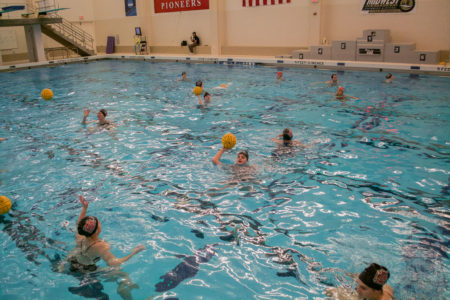


The S&B is going inside sports practices to get a glimpse of what Grinnell student-athletes are actually doing at the Bear in the afternoon. We sent writer Quan Tran ’21 and photographer Elena Copell ’21 to scope out women’s water polo practice.
It’s hot. It’s humid. It’s water polo practice at the natatorium.
This week, I caught up with the women’s water polo team to see how practice is run. At first glance, it seems that the water polo team’s presence looms in the shadows of various swimming and diving records and championships. Alongside other pool-based programs with such a well-known history, it’s easy to think that water polo is just a club activity. That is, until you watch them play.
The women’s water polo season is very short, having only two meets and a conference tournament. With practice only about a week in, today the team captains Shannon Ellery ’18 and Camille Hall ’19 spend the first half an hour of their practice, which lasts from 5 to 6:30 p.m. every Monday, Wednesday and Friday, going through basic rules and formation setups. The point is, as captain Ellery said, to familiarize them with the game.
“A lot of our players have never had water polo experience or … seen water polo played before. So we had a little powerpoint to [help them] learn more about the game,”
It is usually said that water polo is just like soccer, but underwater. And in many ways it is. At the far end of the natatorium, near the diving boards, lies a whiteboard on which the team draws out tactics and assigns match-ups. Finally, at 5:50 p.m., they go into the pool and warm up with a couple laps of freestyle and backstroke. The warm-up scene looks very much like a synchronized swimming practice.
While everything was going on, the captains were taking the goals out and placing them in the water. After warm-ups ended, the players started shooting practice. Again, it’s quite similar to a soccer penalty shootout practice. Ellery gave out instructions to players on how to execute their finish better after every shot. After a while, as the clock was about to strike the 6:00 mark, the most exciting part of any practice began: scrimmages.
As much as the team is about tactics, the scrimmage today was more about letting players find their zone. Unlike soccer, water polo positions, except for the goalie, are more interchangeable and more involved on both ends of the pool. After a breathtaking swim-off for the first possession, everybody was locked in. Even though nobody was keeping score and there was only one referee, formations and match-ups were still intensely deployed.
At one point, a goalie made one amazing save, beating a 3-on-1 counterattack in the process. At another point, tension was going so high that a player was ejected. The scrimmage was everything one could have asked for from a practice session.
For a team that isn’t officially sanctioned as a varsity team by Grinnell’s athletic department, the women definitely made a strong case for why they should be. Throughout the practice, senses of discipline and organization were crystal clear, from the players to the captains. Such a competitive culture definitely stems from Ellery, who was also the swimming team’s captain over last winter. Nevertheless, holding such a role on the water polo team does put her in unchartered waters. Without an actual coach, the team is responsible for traveling and accommodations by themselves.
“In my second year, the athletic department absorbed the club sports, including water polo, into it. I think since then it’s been a lot easier to organize hotel rooms and transportation. … Still, it’s a very different role compared to being a captain of a varsity team since it is a much more administrative role on the water polo side,” Ellery said.
The scrimmage lasted until the near end, when they had to carry the goals out of the pool to make room for diving class afterwards. Even though the game was intense, the team didn’t forget to save an extra five minutes to discuss and encourage each other. Such practice, to Ellery, is very vital to team’s chemistry and individual performances.
“We like to scrimmage a lot because it’s a good way to combine all the skills. It’s easier to just pick up [a] ball and shoot it, but it matters more when you have someone who’s guarding you and you have to swim around and make space,” Ellery said.

























































